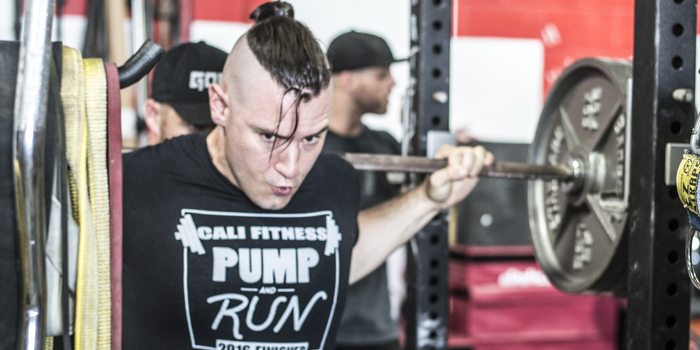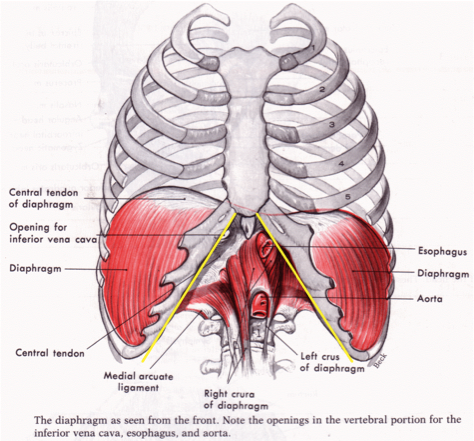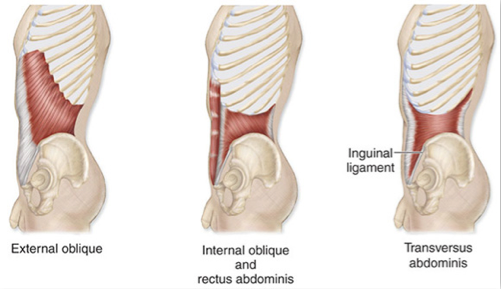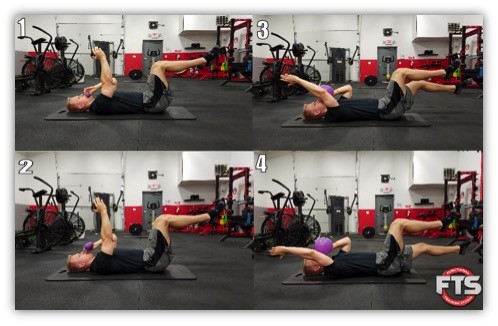
The term “abdominal training” should not be synonymous with the obsolete thought of crunches, sit ups, and planks. Unfortunately, these actions are associated with the outdated term and sub-optimal training method. Instead, choose a more functional approach in combination with Postural Restoration Institute (PRI) to optimize ribcage position with simultaneous abdominal strengthening.
PART 1: Fatigue vs Fatigue Compensation — Manual Resistance
In doing so, two desired goals can be achieved: create an optimal breathing pattern and appropriate limb movement to better resist fatigue compensation.
1. Improve breathing mechanics through positional facilitation.
An optimal ribcage position will enhance the ability to breathe. According to the concepts of PRI, when a 90-degree infrasternal angle is achieved through oblique activation, the domed position creates enhanced diaphragmatic mechanics. Leveraging the primary muscles of respiration without accessory muscles helps control the central nervous system with concurrent improvements in respiratory capacity. Furthermore, improving respiratory capacity resists the faulty breathing patterns that are apparent during fatigue compensation.
Figure 1: The Diaphragm is a muscle – stretch and strengthen it! (yogadork.com)
Improve rib cage position through oblique facilitation. The external oblique’s originate on rib 5 and run inferior and at an oblique axis into its insertion of the iliac crest. The contraction of the oblique’s will draw the ribs down and in, while aiding in an increase in intra-abdominal pressure. Oblique contraction provides the sensory and motor system a new method to develop trunk stability without supplementary help from the low back. As a result, low back inhibition will accomplish the desired breathing paradigm. In addition, new methods of breathing are rerouted throughout the system with the absence of the low back “pulling” air in a compensatory fashion.
Figure 2: Muscles of the Abdominal Wall - (Antranik.org)
Balloons can be utilized to subconsciously create external resistance for new methods of respiration. Respiration begins by inhaling through the nose and completed with a pause. As you exhale, ensure all of the air is expelled into the balloon with noticeable chest and rib cage depression. The trick to sustaining oblique contraction is to imagine “exhaling while you inhale.”
For example, when you approach the absence of air during the exhalation phase, sustain pressure by “continuing to exhale.” No air will be exhaled into the balloon per se, but sustaining pressure signals the brain to preserve sufficient oblique tension. As pressure is sustained, take an inhale through the nose. The obliques should be engaged as the upper chest and back begin to expand. Continue this process for four breaths while keeping in mind: rib cage down, sustained exhalation, and oblique activation.
Fatigue compensation will be reduced through this positional oblique facilitation. Using this simple training method will provide carryover in the weight room. When the central nervous system is stressed from exercise, it panics. The old method of panic was once one that transported air by any means necessary. The new paradigm remains controlled under the most stressful conditions. Through oblique facilitation training, fatigue compensation will be inhibited by the new breathing techniques.
2. Create a foundation.
Abdominal training can also be utilized to develop limb movement on a non-compensatory foundation. We all need to move our limbs whether it is to exercise, perform a task, or carry out daily activities in life. A traditional abdominal strengthening program looks at the core (foundation) without consideration of the limbs. Conversely, we want to look at the limbs to build a stable core. Unwanted abdominal exercises bias a flared rib cage, lumbar extension, and a poorly flexed spine. What’s wrong with these patterns? These are patterns that create low back pain, shoulder impingement, hip impingement, and many of the overuse injuries commonly seen. Can you move your limbs to an optimal range without compensation?
Use a modified dead bug to improve limb range on a non-compensated foundation. The dead bug is a traditional abdominal exercise that is prescribed for many with low back pain. However, when performed in the traditional method, the thorax, pelvis, and breath are not taken into enough consideration.
To modify, add a balloon to the exercise and perform it as follows:
Begin the exercise by determining the most appropriate starting position. More novice athletes or those with pain should start with more limb ground contact. On the other hand, advanced athletes can begin with legs and arms off the ground. From here, the exercise will be performed similarly to the traditional dead bug. Initiate with a posterior pelvic tilt to flatten the low back with coinciding rib depression. At this point, the outer abdominals (obliques) should feel as though they are slightly engaged.
Next, a proper inhale is initiated and is followed up with a full exhalation into the balloon. This will further contract the obliques and depress the ribcage with additional flattening of the low back. At this point, you are clear to move the appropriate limbs depending on your starting position. As you move, you should feel a stronger sense of stability, control, and strength added from the positional variances achieved from the balloon. The neuromuscular connection demonstrates how to appropriately move the limbs without compensation (lumbar extension). This is vital to learn in order to reduce your fatigue compensation. Without this understanding, as you fatigue, you will fall into one of the above-mentioned compensations and have to prematurely stop the given exercise.
In summary, fatigue compensation can be resisted through proper oblique facilitation, breathing mechanics, and limb motion. Always seek to establish the best possible position prior to the given task. Once the position is achieved, breathing and motion are utilized to further bias the optimal pattern. When trained, this position can help athletes develop explosive power, strength, and stability. Most importantly, this is all done at the expense of a proper learned movement pattern to resist fatigue compensation.
Brian is an up-and-coming strength and conditioning coach. He is the owner of Functional Training Studio in Charlotte, North Carolina. At a young age, Brian has been training clients for over six years and is always looking at ways to improve his technique. He utilizes positional asymmetries that exist within the body to help clients and athletes improve their function and overall performance capacity. Brian has a degree in exercise science and is a certified strength and conditioning coach through the NSCA. Additionally, he plans to continue his education in 2017 in a doctorate of physical therapy program. For additional questions, Brian can be reached at FTStudio130@gmail.com.












